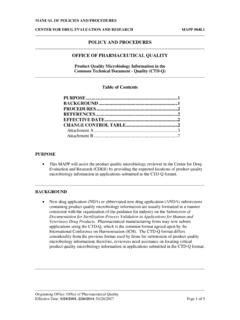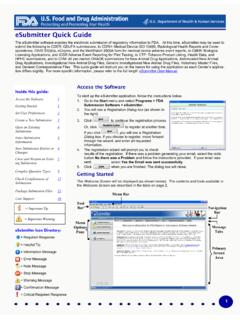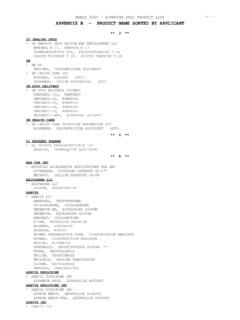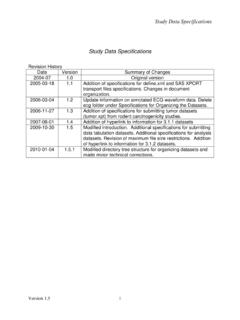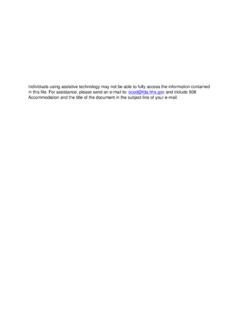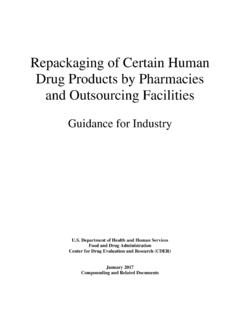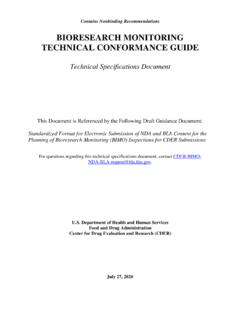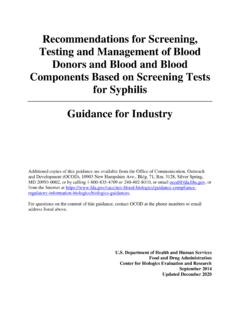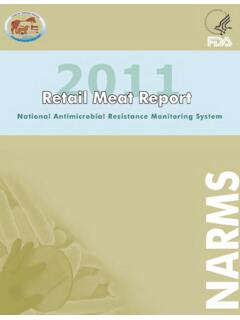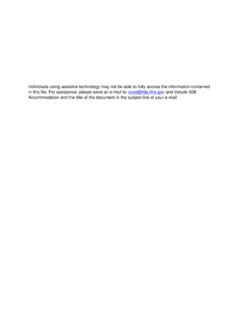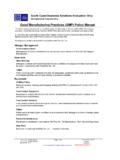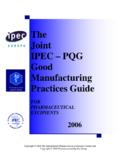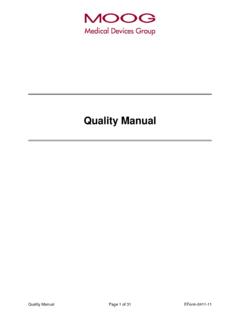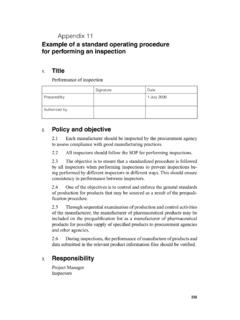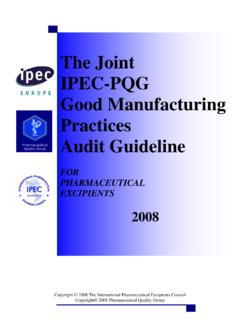Transcription of POLICY AND PROCEDURES OFFICE OF …
1 manual OF POLICIES AND PROCEDURES CENTER FOR DRUG EVALUATION AND RESEARCH MAPP Originating OFFICE : OFFICE of pharmaceutical quality Effective Date: 3/9/2009; Recertification 4/22/2014; 6/30/2017 Page 1 of 4 POLICY AND PROCEDURES OFFICE OF pharmaceutical quality Acceptance Criteria for Residual Solvents Table of Contents PURPOSE ..1 BACKGROUND ..1 POLICY ..2 RESPONSIBILITIES AND PROCEDURES ..3 REFERENCES ..4 EFFECTIVE DATE ..4 CHANGE CONTROL TABLE ..4 PURPOSE This MAPP provides recommendations to product quality reviewers who assess chemistry, manufacturing, and controls (CMC) within the OFFICE of pharmaceutical quality on the appropriate use of International Conference on Harmonisation (ICH) recommendations during the evaluation of acceptance criteria for residual solvents in drug substances and products proposed in new drug applications, abbreviated new drug applications, biologics license applications, and related supplements.
2 BACKGROUND In 1997, the Food and Drug Administration published the ICH guidance for industry, Q3C Impurities: Residual Solvents (ICH Q3C). The guidance divides solvents into three risk-based classes: Class 1 solvents, which are known to cause unacceptable toxicities; Class 2 solvents, which are associated with less severe toxicity; and Class 3 solvents, which have low toxic potential. The guidance also introduces the concept of permitted daily exposure (PDE) and provides the PDE or corresponding concentration limits for Class 1 and Class 2 solvents. With regard to PDE limits, the guidance says the following: Since there is no therapeutic benefit from residual solvents, all residual solvents should be removed to the extent possible to meet product specifications, good manufacturing practices, or other quality -based requirements. In discussing PDE limits for manual OF POLICIES AND PROCEDURES CENTER FOR DRUG EVALUATION AND RESEARCH MAPP Originating OFFICE : OFFICE of pharmaceutical quality Effective Date: 3/9/2009; Recertification 4/22/2014; 6/30/2017 Page 2 of 4 Class 2 solvents, it states that, The limits should be realistic in relation to analytical precision, manufacturing capability, and reasonable variation in the manufacturing process and the limits should reflect contemporary manufacturing standards.
3 Regarding Class 3 solvents, the guidance suggests that these are Solvents with low toxic potential to man; no health-based exposure limit is is considered that amounts of these residual solvents of 50 mg per day or less (corresponding to 5,000 ppm or percent under Option 1) would be acceptable without justification. Higher amounts may also be acceptable provided they are realistic in relation to manufacturing capability and good manufacturing practice (GMP). Since the publication of ICH Q3C, sponsors and applicants frequently have proposed acceptance criteria for residual solvents in drug substances or products to the Agency based on the levels the guidance recommended as safe. Although such proposals were accepted in some cases, CMC reviewers frequently considered manufacturing history to be an overriding factor to what ICH Q3C recommends. For example, if an application indicated that the levels of Class 3 solvents in developmental batches were consistently much lower than 5,000 parts per million (ppm), an applicant proposing 5,000 ppm as an acceptance criterion often would be asked to set a lower acceptance criterion to reflect its batch experience.
4 This MAPP is intended to encourage CMC reviewers to take more of a risk-based approach when assessing proposed acceptance criteria for residual solvents. The MAPP was developed partly to recognize that material control PROCEDURES such as track and trend programs that companies use under their quality systems often mitigate the need for tight controls on residual levels of Class 3 solvents during release testing. POLICY Class 3 Solvents The ICH Q3C PDE limit of 50 milligrams (mg) per day (or percent under Option 1) for Class 3 solvents is generally allowable as an acceptance criterion without justification for all dosage forms. Limits above these, implied by ICH Q3C to be acceptable, will be considered on a case-by-case basis. Lower limits, based on safety and efficacy considerations unique to certain dosage forms and clinical indications, should be discussed with the multidisciplinary review team, and appropriate management personnel should concur with any decisions regarding such limits.
5 A manufacturing history indicating that solvent levels lower than 50 mg per day are consistently manual OF POLICIES AND PROCEDURES CENTER FOR DRUG EVALUATION AND RESEARCH MAPP Originating OFFICE : OFFICE of pharmaceutical quality Effective Date: 3/9/2009; Recertification 4/22/2014; 6/30/2017 Page 3 of 4 attainable is, in itself, insufficient justification for setting lower acceptance criteria. If information in an application indicates that Class 3 solvents could adversely affect quality attributes such as stability when present at levels consistent with ICH Q3C, it may be appropriate to set the acceptance criteria for those solvents below ICH Q3C levels to reduce or prevent the adverse effect. Class 2 Solvents Acceptance criteria for Class 2 solvents should continue to be set on a risk-based, case-by-case basis, taking into consideration issues of safety and product quality . Class 1 Solvents As stated in ICH Q3C, Solvents in Class 1.
6 Should not be employed in the manufacture of drug substances, excipients, and drug products because of their unacceptable toxicity or their deleterious environmental effect. However, if their use is unavoidable .. then their levels should be restricted as shown in Table 1 [of the guidance], unless otherwise justified. Consequently, CMC review personnel should encourage sponsors to use alternative solvents. When possible, such recommendations should be made while the drug is still in the early stage of development. RESPONSIBILITIES AND PROCEDURES Sponsors are responsible for determining appropriate levels of residual solvents in their drug substances and products, taking into account both the levels ICH Q3C recommended as safe and the potential adverse effects on drug product quality that might result from the presence of residual solvents at such levels. Justification should be provided in the application for any proposed acceptance criteria that exceed the levels ICH Q3C recommended as safe.
7 The CMC reviewer should assess proposed acceptance criteria for residual solvents to determine whether the criteria are consistent with the goal of ensuring product quality . Proposed acceptance criteria that exceed the levels that ICH Q3C recommends should be discussed with the multidisciplinary review team or management personnel, as appropriate. Limits on Class 3 solvents lower than the levels recommended in ICH Q3C, unless proposed by the applicant, should not be discussed with the applicant unless the appropriate management personnel first concur to the lower limits based on the review team discussion and safety and efficacy considerations. manual OF POLICIES AND PROCEDURES CENTER FOR DRUG EVALUATION AND RESEARCH MAPP Originating OFFICE : OFFICE of pharmaceutical quality Effective Date: 3/9/2009; Recertification 4/22/2014; 6/30/2017 Page 4 of 4 The respective Team Leader, Branch Chief, and Division Director are responsible for the appropriate application of this MAPP.
8 REFERENCES ICH Guidance for Industry, Q3C Impurities: Residual Solvents EFFECTIVE DATE This MAPP is effective upon date of publication. CHANGE CONTROL TABLE Effective Date Revision Number Revisions 3/9/2009 original N/A 4/22/14 Recertification, no changes 6/30/17 Administrative changes
